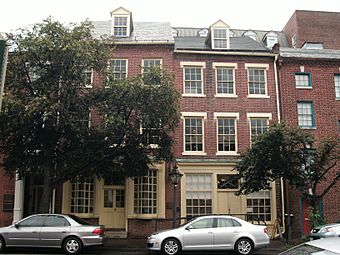Stabler-Leadbeater Apothecary Shop facts for kids
|
Stabler-Leadbeater Apothecary Shop
|
|
 |
|
| Location | 105–107 S. Fairfax, Alexandria, Virginia |
|---|---|
| Area | less than one acre |
| Built | 1775 |
| NRHP reference No. | 82001796, 100006254 |
Quick facts for kids Significant dates |
|
| Added to NRHP | November 24, 1982 |
| Designated NHL | January 13, 2021 |
The Stabler-Leadbeater Apothecary Shop/Museum is a super old pharmacy in Alexandria, Virginia. It's now a museum where you can see what a pharmacy was like long ago!
This special shop was run by a Quaker family for many years. They sold medicines and other goods. When times got tough during the Great Depression, the shop had to close. But it didn't stay closed for long! In 1939, it reopened as a museum.
Today, almost everything you see inside is real and from when the shop closed. The building is so important that it was added to the National Register of Historic Places in 1982. It was even named a National Historic Landmark in 2021.
Contents
A Look Back: The Shop's History
The story of this unique shop began with Edward Stabler. He learned the pharmacy business from his brother. In 1792, he opened his own shop in Alexandria. Edward was a smart businessman and a devoted Quaker.
He first rented a space, then bought the building at 107 S. Fairfax Street in 1805. Later, in 1829, he bought the building next door at 105 S. Fairfax. This made his apothecary business even bigger!
What They Sold
Edward Stabler sold many different things to people in the city and the countryside. His customers included famous people like Martha Washington and Robert E. Lee. He also served local doctors and farmers.
The shop offered medicines, farm tools, surgical tools, and even dental equipment. You could also buy soap, perfume, cigars, window glass, paint, and art supplies. Many medicines were made right there in the shop using plants and herbs.
Passing Down the Business
As Edward Stabler got older, his oldest son, William, started helping more. William took over the business after his father passed away in 1831. William kept it a family business, bringing in his brothers and his brother-in-law, John Leadbeater.
John Leadbeater was also a trained pharmacist and dentist. When William passed away in 1852, John bought the business from William's wife. He then changed the name to John Leadbeater.
The Civil War Years
When the American Civil War started, Union soldiers quickly took over Alexandria. The shop's records show how busy they were! After a big battle called the First Battle of Manassas, many Union soldiers came to the shop.
They lined up to buy "Hot Drops," a cough medicine with paprika and alcohol. These drops were very popular, selling for just a cent each. The shop sold over $1,000 worth in a single day!
Growth and Challenges
In 1865, John's son, Edward, took over the shop. The business grew a lot, supplying medicines to nearly 500 pharmacies around Washington D.C. At its busiest, the Leadbeaters had 12 salespeople. They traveled across Virginia, West Virginia, and North Carolina.
The company even had 11 buildings in Alexandria and an office in Washington, D.C. But as new commercial pharmacies and modern drug companies appeared, the family business faced tough competition. The economy also slowed down.
By 1933, during the Great Depression, the Leadbeater Drug Co. had to declare bankruptcy. This happened just days before the owner, Edward S. Leadbeater, Jr., passed away.
Saving History: Becoming a Museum
People in Alexandria and a man named L. Manuel Hendler from Baltimore wanted to save the shop's amazing collection. They knew it was a piece of history! In 1933, they bought most of the shop's contents and old records at an auction.
The next year, a new group called the Landmarks Society of Alexandria bought the buildings. Mr. Hendler then gave all the contents and records to the Landmarks Society.
The buildings were carefully restored to look like they did in the 1700s. The museum officially opened in 1939. It was free to visit thanks to help from the American Pharmaceutical Association. After more renovations, the Landmarks Society gave the museum to the City of Alexandria in 2006.
What You See at the Museum Today
The museum is filled with thousands of old items. They are still on the shelves exactly where they were when the shop closed! You can also see beautiful old furniture from before the Civil War.
After a big restoration in 2006, visitors can now explore the second floor too. This floor has a former warehouse room used for events. There's also a manufacturing room where medicines were made. This room looks almost exactly as it did in 1933!
The museum offers tours every day for families and individuals. You can also book group tours. There is a small fee for tours, which helps keep the museum running. The museum's hours change with the seasons. They also have fun programs like Girl Scout workshops, talks about old medicines, and themed birthday parties.
Famous Visitors
Many important people visited the Stabler-Leadbeater Apothecary Shop over the years:
- Elisha C. Dick, who was George Washington's doctor.
- Martha Washington (in 1802).
- James Monroe, a former U.S. President.
- Eleanor Parke Custis Lewis.
- Robert E. Lee, who bought paint for his home, the Arlington House.
Images for kids





